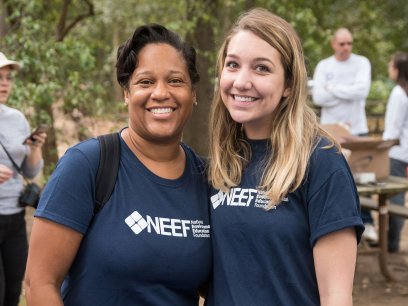
Commemorating those who died while serving in the US military, Memorial Day is a time for reflection and respect. It also unofficially marks the beginning of the summer season. Every year, Memorial Day weekend is marked with hot dogs and hamburgers, melting popsicles, and lots of time spent outdoors. While you have "fun in the sun" this weekend, remember to protect your health. Exposure to ultraviolet (UV) radiation from the sun can have damaging health consequences like skin cancer and eye damage, particularly among children, for whom the risks associated with UV radiation are increased. The Friday before Memorial Day has been designated “Don't Fry Day” by the National Council on Skin Care Prevention, with a goal of encouraging sun safety awareness by reminding everyone to take the right precautions to prevent UV radiation overexposure so that time spent outside can be fun and safe. To help educators, parents, caregivers, and others teach and model sun safe behaviors, NEEF has updated and re-released its popular SunWise Tool Kit.
What is UV Radiation?
Ultraviolet (UV) radiation is a range of energy emitted by the sun that is responsible for sunburns and other adverse health effects. The intensity of UV radiation that we feel on earth depends on a number of factors. The sun's UV radiation levels are highest during the middle of the day, during the summer months, and at locations closer to the equator. In addition, as the ozone layer has thinned due to the release of ozone-depleting substances, absorption of UV rays has also decreased. There are three types of UV radiation: UVA, UVB, and UVC. Luckily, the ozone layer shields humans from most UV radiation, including UVC and most UVB rays. However, the UVA and UVB radiation that reaches the earth's surface contributes to serious health effects listed below.
Health Effects of Overexposure to Ultraviolet Radiation
One of the most well-known adverse health effects of overexposure to UV radiation is skin cancer. Alarmingly, one in five Americans develop skin cancer in their lifetime. In addition, overexposure to UV radiation can have other damaging health effects, such as eye damage, cataracts, immune system suppression, and premature aging of skin. Contrary to some popular beliefs, although darker skin has more natural pigment, which acts as a protectant, darker skin is still susceptible to many of the damaging effects of UV radiation. It's important for people of all ages and backgrounds to be educated on sun safety in order to reduce the risk of UV-related health problems.
NEEF's SunWise Program and Action Steps for Sun Protection
In order to help increase sun protection, NEEF's SunWise program raises sun safety awareness and fosters behavior change among youth. The SunWise Tool Kit provides activities for kids in grades K-8, allowing children to explore, assess, and understand their natural environment and the factors that affect their health. The participants are encouraged to be physically active while protecting themselves from UV radiation. The SunWise Program is a great way to educate children on the environment and their health in a fun, interactive, and engaging way. The tool kit isn't just for traditional educators—parents, caregivers, and other informal educators can join the Sunwise Program and receive the free tool kit with over 50 cross-cultural, standards-based activities.
Whenever you spend time outside, remember these SunWise Action Steps for Sun Protection:
- apply broad-spectrum, SPF 30 or higher sunscreen to all exposed skin, reapplying every two hours and after swimming or sweating;
- wear protective clothing, such as long-sleeve shirts and pants;
- set sun-safe fashion trends by wearing a hat;
- rock a pair of sunglasses for eye protection;
- seek shade when needed: the sun's UV rays are strongest between 10AM and 4PM;
- check the UV Index before planning outdoor activities;
- avoid sun tanning and tanning beds; and
- get vitamin D safely, through vitamin supplements and fortified foods.
The following is a list of resources for more information on sun safety
- Register to receive the free SunWise Tool Kit: http://go.neefusa.org/sunwise
- Check the outdoor air quality with AirNow: https://www.airnow.gov/
- View the EPA's UV Index: https://www.epa.gov/sunsafety/uv-index-1
- Learn about how animals protect themselves from the sun's rays: https://www.neefusa.org/resource/who-am-i-sunwise-animals
- Learn more about UV radiation: https://www.neefusa.org/learn-more-about-uv-radiation
- Check out this helpful infographic from the American Cancer Society: https://www.cancer.org/research/infographics-gallery/skin-cancer-prevention.html
Sources
- EPA. 2018. Don't Fry Day. Environmental Protection Agency. Accessed May 22. https://www.epa.gov/sunsafety/dont-fry-day
- Don't Fry Day. 2018. National Council on Skin Cancer Prevention. Accessed May 22. https://www.skincancerprevention.org/programs/dont-fry-day
- NEEF. 2018. NEEF SunWise. National Environmental Education Foundation. https://www.neefusa.org/sunwise
- NEEF. 2018. Learn More About UV Radiation. National Environmental Education Foundation. https://www.neefusa.org/learn-more-about-uv-radiation#UV%20Index
- NEEF. 2018. Action Steps for Sun Protection. National Environmental Education Foundation. https://www.neefusa.org/action-steps-sun-protection


